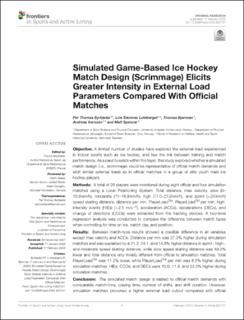| dc.contributor.author | Byrkjedal, Per Thomas | |
| dc.contributor.author | Bjørnsen, Thomas | |
| dc.contributor.author | Ivarsson, Andreas | |
| dc.contributor.author | Spencer, Matthew | |
| dc.contributor.author | Luteberget, Live Steinnes | |
| dc.date.accessioned | 2022-08-04T11:43:54Z | |
| dc.date.available | 2022-08-04T11:43:54Z | |
| dc.date.created | 2022-04-03T19:48:31Z | |
| dc.date.issued | 2022 | |
| dc.identifier.citation | Frontiers in Sports and Active Living. 2022, 4, Artikkel 822127. | en_US |
| dc.identifier.issn | 2624-9367 | |
| dc.identifier.uri | https://hdl.handle.net/11250/3010151 | |
| dc.description | This is an open-access article distributed under the terms of the Creative Commons Attribution License (CC BY). The use, distribution or reproduction in other forums is permitted, provided the original author(s) and the copyright owner(s) are credited and that the original publication in this journal is cited, in accordance with accepted academic practice. No use, distribution or reproduction is permitted which does not comply with these terms. | en_US |
| dc.description.abstract | Objective: A limited number of studies have explored the external load experienced in indoor sports such as ice hockey, and few the link between training and match performance. As a paucity exists within this topic, this study explored whether a simulated match design (i.e., scrimmage) could be representative of official match demands and elicit similar external loads as in official matches in a group of elite youth male ice hockey players.
Methods: A total of 26 players were monitored during eight official and four simulation matches using a Local Positioning System. Total distance, max velocity, slow (0–10.9 km/h), moderate (11–16.9 km/h), high (17.0–23.9 km/h), and sprint (>24 km/h) speed skating distance, distance per min, PlayerLoadTM, PlayerLoadTM per min, high-intensity events (HIEs) (>2.5 m/s−2), acceleration (ACCs), decelerations (DECs), and change of directions (CODs) were extracted from the tracking devices. A two-level regression analysis was conducted to compare the difference between match types when controlling for time on ice, match day, and position.
Results: Between match-type results showed a credible difference in all variables except max velocity and ACCs. Distance per min was 27.3% higher during simulation matches and was explained by a 21.3, 24.1, and 14.8% higher distance in sprint-, high-, and moderate speed skating distance, while slow speed-skating distance was 49.2% lower and total distance only trivially different from official to simulation matches. Total PlayerLoadTM was 11.2% lower, while PlayerLoadTM per min was 8.5% higher during simulation matches. HIEs, CODs, and DECs were 10.0, 11.9, and 22.3% higher during simulation matches.
Conclusion: The simulated match design is related to official match demands with comparable match-time, playing time, number of shifts, and shift duration. However, simulation matches provoked a higher external load output compared with official matches, possibly explained by a more continuous movement design. A game-based simulation match design can therefore be utilized when match-related actions at high intensity are warranted. | en_US |
| dc.language.iso | eng | en_US |
| dc.subject | athlete monitoring | en_US |
| dc.subject | game-based training | en_US |
| dc.subject | IMU | en_US |
| dc.subject | inertial measurements units | en_US |
| dc.subject | Local Positioning System | en_US |
| dc.subject | LPS | en_US |
| dc.subject | team sports | en_US |
| dc.title | Simulated game-based ice hockey match design (scrimmage) elicits greater intensity in external load parameters compared with official matches | en_US |
| dc.type | Peer reviewed | en_US |
| dc.type | Journal article | en_US |
| dc.description.version | publishedVersion | en_US |
| dc.rights.holder | © 2022 Byrkjedal, Luteberget, Bjørnsen, Ivarsson and Spencer | en_US |
| dc.source.pagenumber | 9 | en_US |
| dc.source.volume | 4 | en_US |
| dc.source.journal | Frontiers in Sports and Active Living | en_US |
| dc.identifier.doi | 10.3389/fspor.2022.822127 | |
| dc.identifier.cristin | 2014933 | |
| dc.description.localcode | Institutt for fysisk prestasjonsevne / Department of Physical Performance | en_US |
| dc.source.articlenumber | 822127 | en_US |
| cristin.ispublished | true | |
| cristin.fulltext | original | |
| cristin.qualitycode | 1 | |
